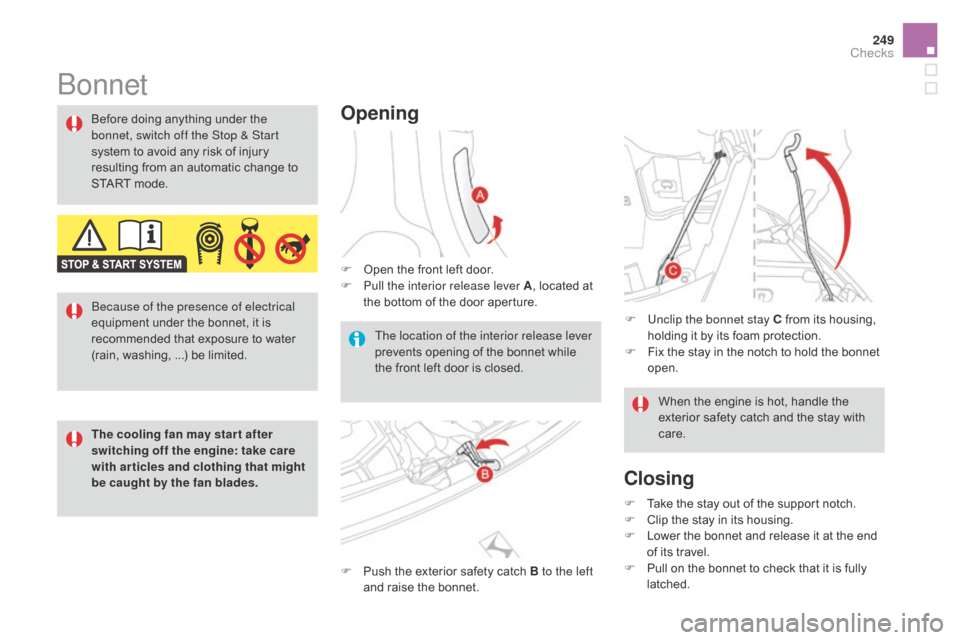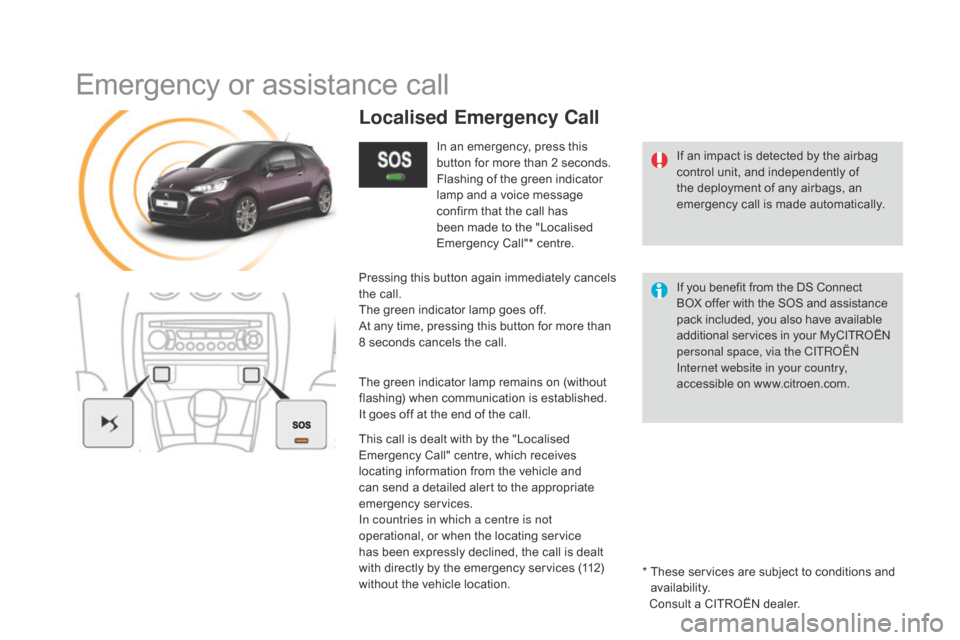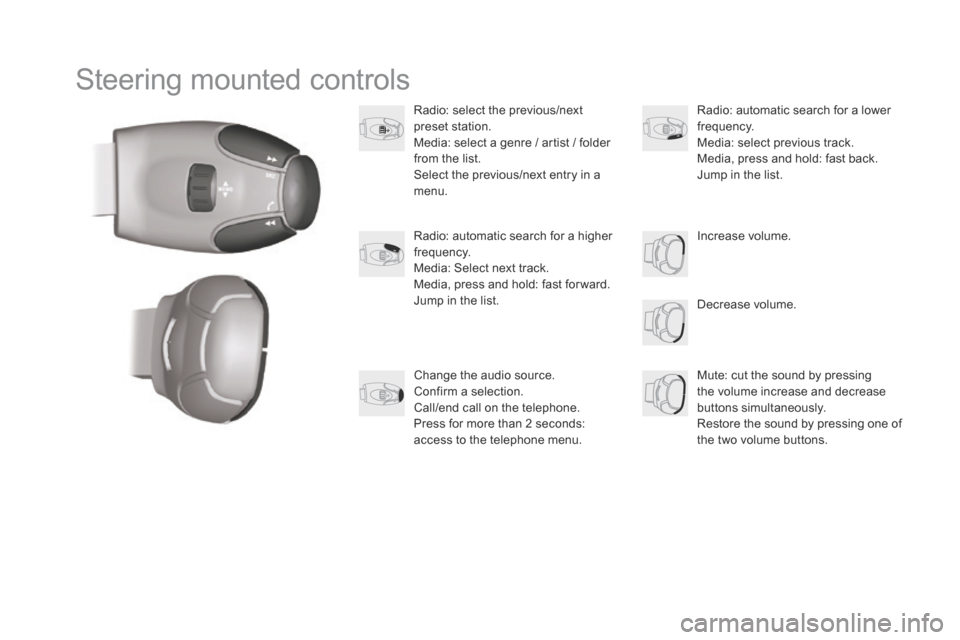automatic Citroen DS3 RHD 2016 1.G Repair Manual
[x] Cancel search | Manufacturer: CITROEN, Model Year: 2016, Model line: DS3 RHD, Model: Citroen DS3 RHD 2016 1.GPages: 380, PDF Size: 10.11 MB
Page 233 of 380

231
12 V battery
The battery is located under the bonnet.
T o gain access to it:
F
o
pen the bonnet using the interior release
l
ever, then the exterior safety catch,
F
s
ecure the bonnet stay,
F
l
ift the plastic cover on the (+) terminal.
Access to the battery
Procedure for starting the engine using another battery or charging a discharged battery.
general points
Lead-acid starter batteries
Batteries contain harmful substances such as sulphuric acid and lead.
They
must be disposed of in
a
ccordance with regulations and must
n
ot,
i
n
a
ny
c
ircumstances,
b
e
d
iscarded
w
ith household waste.
Take
used remote control batteries and
v
ehicle batteries to a special collection
point.
Versions
equipped with Stop &
S
tart are fitted with a 12 V lead-acid
b
attery of specific technology and
s
pecification.
Its
replacement should be carried
o
ut only by a CITROËN dealer or a
q
ualified
w
orkshop. Protect
your eyes and face before
h
andling the battery.
All
operations on the battery must be
c
arried out in a well ventilated area and
a
way from naked flames and sources
o
f sparks, so as to avoid the risk of
e
xplosion or fire.
Wash
your hands after wards.
If
you have an electronic or automatic
g
earbox, never try to start the engine
b
y pushing the vehicle.The
(-) battery terminal is not accessible.
A
remote earthing point is located on the front
l
eft-hand
w
ing
pan
el.
Practical information
Page 237 of 380

235
Load reduction modeSystem which manages the use of certain functions according to the level of charge
r
emaining in the battery.
When
the vehicle is being driven, the load
r
eduction function temporarily deactivates
c
ertain functions, such as the air conditioning,
t
he heated rear screen...
The
deactivated functions are reactivated
a
utomatically as soon as conditions permit.Energy economy modeSystem which manages the period of use of certain functions to conserve a sufficient level of c
harge in the battery.
After
the engine has stopped, you can still use functions such as the audio equipment, windscreen
w
ipers, dipped beam headlamps, courtesy lamps, etc. for a maximum combined period of
t
hirty minutes. This
period may be greatly reduced if
t
he battery is not fully charged.
A
flat battery prevents the engine from
s
tarting.
If
the telephone is being used at the
s
ame time, it will be interrupted after
10
m
inutes.
Switching to economy mode
Once this period has elapsed, a message appears in the screen indicating that the
v
ehicle has switched to economy mode and the
a
ctive functions are put on standby.
Exiting economy mode
These functions are reactivated automatically the next time the vehicle is driven.
F
I
n order to resume the use of these
f
unctions immediately, start the engine and
l
et it run for a few minutes.
The
time available to you will then be double
t
he period for which the engine is left running.
H
owever, this period will always be between
f
ive and thirty minutes.
Practical information
Page 240 of 380

F On the front bumper, unclip the access flap b
y pulling successively on the two lugs,
u
sing a screwdriver.
F
R
otate the flap.
F
C
ompletely remove the flap, by
c
ompressing the plastic diamond shape
l
ocated in the lower section.
F
S
tore the flap in the boot.
F
S
crew the towing eye in fully.
F
I
nstall the towing arm. F
O n the rear bumper, unclip the cover by p
ressing at the bottom.
F
S
crew the towing eye in fully.
F
I
nstall the towing arm.
F
S
witch on the hazard warning lamps on
b
oth vehicles.
F
M
ove off gently and drive for a short
d
istance
o
nly.
Towing your vehicleTowing another vehicle
Failure to observe this instruction could r
esult in damage to certain components
(
braking, transmission...) and the
a
bsence of braking assistance the next
t
ime the engine is started.
F
U
nlock the steering by turning the key one
n
otch in the ignition switch and release the
par
king
b
rake.
F
S
witch on the hazard warning lamps on
b
oth vehicles.
F
M
ove off gently and drive for a short
d
istance
o
nly.
F
P
lace the gear lever in neutral (position n
for an electronic or automatic gearbox).
Page 242 of 380

Towing with the gT RACIn g version
Your vehicle cannot be fitted with a t
owbar. The space occupied by the
s
port diffuser prevents this.
Side wind
F Take into account the increased sensitivity t
o side wind.
Cooling
Towing a trailer on a slope increases the temperature of the coolant.
As
the fan is electrically controlled, its cooling
c
apacity is not dependent on the engine speed.
F
T
o lower the engine speed, reduce your
s
peed.
The
maximum towed load on a long incline
d
epends on the gradient and the ambient
t
emperature.
In
all cases, keep a check on the coolant
t
emperature. F
I
f the warning lamp and the
S
TOP
warning lamp come on,
s
top the vehicle and switch off
t
he engine as soon as possible.
Braking
Towing a trailer increases the braking distance.
T o avoid overheating of the brakes on a long
m
ountain type of descent, the use of engine
b
raking is recommended.
Ty r e s
F Check the tyre pressures of the towing v
ehicle and of the trailer, observing the
re
commended
p
ressures.
Lighting
F Check the electrical lighting and signalling o
n the trailer.
The
rear parking sensors will be
d
eactivated automatically if a genuine
C
ITROËN towbar is used.
Page 251 of 380

249
Bonnet
Opening
F Open the front left door.
F P ull the interior release lever A ,
located at
t
he bottom of the door aperture.
F
P
ush the exterior safety catch B to the left
and
raise the bonnet.
Before
doing
anything
under
the
b
onnet, switch off the Stop & Start
system
to
avoid
any
risk
of
injury
r
esulting
from
an
automatic
change
to
S
TART
mode.
The location of the interior release lever
prevents opening of the bonnet while
t
he front left door is closed.F
U
nclip the bonnet stay C from its housing,
h
olding it by its foam protection.
F
F
ix the stay in the notch to hold the bonnet
ope
n.
Closing
F Take the stay out of the support notch.
F C lip the stay in its housing.
F
L
ower the bonnet and release it at the end
o
f its travel.
F
P
ull on the bonnet to check that it is fully
l
atched.When
the engine is hot, handle the
e
xterior safety catch and the stay with
c
are.
Because of the presence of electrical
equipment
under
the
bonnet,
it
is
r
ecommended
that
exposure
to
water
(
rain,
washing, ...)
be
limited.
The cooling fan may star t after
switching off the engine: take care
with articles and clothing that might
be caught by the fan blades.
Checks
Page 259 of 380

257
Manual gearbox
Automatic gearboxBrake pads
Brake wear depends on the style o
f driving, particularly in the case o
f vehicles used in town, over short
d
istances. It may be necessary to have
t
he condition of the brakes checked,
e
ven between vehicle services.
The
gearbox
does
not
require
any
m
aintenance
(no
oil
change).
Refer
to
the
manufacturer's
service
s
chedule
for
the
checking
interval
for
t
his
c
omponent.
Only
use products recommended by
C
ITROËN or products of equivalent
q
uality
an
d
sp
ecification.
In
order to optimise the operation of
u
nits as important as those in the
b
raking system, CITROËN selects and
o
ffers very specific products.
The
gearbox
does
not
require
any
m
aintenance
(no
oil
change).
Refer
to
the
manufacturer's
service
s
chedule
for
details
of
the
level
c
hecking
interval
for
this
component.
Electronic gearbox
The gearbox does not require any m aintenance (no oil change).
Refer
to the manufacturer's service
s
chedule for details of the checking
i
nterval for this component. For
information on checking brake
d
isc wear, contact a CITROËN dealer
o
r a qualified workshop.
Brake disc wearParking brake
If excessive travel or a loss of e
ffectiveness of this system is
n
oticed, the parking brake must be
c
hecked, even between two services.
Unless
there
is
a
leak
in
the
circuit,
a
drop
in
t
he
brake
fluid
level
indicates
that
the
brake
p
ads
are
worn. Checking
this system must be done by a
C
ITROËN dealer or a qualified workshop.
After
washing
the
vehicle,
dampness,
o
r
in
wintry
conditions,
ice
can
form
o
n
the
brake
discs
and
pads:
braking
e
fficiency
may
be
reduced.
Make
light
b
rake
applications
to
dry
and
defrost
t
he
brakes.
Checks
Page 262 of 380

Petrol enginePureTech 82PureTech 82 S&S V Ti 120
ge
arbox Manual
(5-speed) ETG
electronic
(
5-speed)Manual
(5-speed) Automatic
(
4-speed)
Model code:
SA... HMZ6
HMZ6/PS 5FS05FS9
Cubic
capacity (cc) 1 19 91 19 9 1 598
Bore
x stroke (mm) 75
x 90.575
x 90.577
x 85.8
Max
power: EU standard (kW)* 6060 88
Max
power engine speed (rpm) 5 7505 750 6 000
Max
torque: EU standard (Nm) 118118 160
Max
torque engine speed (rpm) 2 7502 750 4 250
Fuel UnleadedUnleaded Unleaded
Catalytic converter yesYe s yes
Engine
oil capacity (in litres) (with filter
r
eplacement) 3.25
3.25 4.25
*
T
he maximum power corresponds to the value type-approved on a test bed, under conditions defined in European legislation
(Directive
1
999/99/EC).
Petrol engines
Page 265 of 380

263
The GTW and towed load values indicated are valid up to a maximum altitude of 1 000 metres; the towed load mentioned must be reduced by 10 % for each additional 1 000 metres of altitude.
The
speed of a towing vehicle must not exceed 60 mph (100 km/h) (comply with the legislation in force in your country).
High
ambient temperatures may result in a reduction in the per formance of the vehicle to protect the engine; if the ambient temperature is above 37 °C,
l
imit the towed load.
*
T
he weight of the braked trailer can be increased, within the GTW limit, if the GV W of the towing vehicle is reduced by an equal amount. Warning:
t
owing using a lightly loaded towing vehicle may have an adverse effect on its road holding.
Petrol engine
PureTech 82PureTech 82 S&S V Ti 120
ge
arbox
Manual
(
5-speed)
ETG electronic
(
5-speed)
Manual
(
5-speed)
Automatic
(
4-speed)
Model code:
SA... HMZ6
HMZ6/PS 5FS05FS9
Unladen weight
9 749801 075 1 089
Kerb weight
1 0491 055 1 1501 16 4
Gross vehicle weight (GV W)
1 5111 523
1 554 1 587
Gross train weight (GTW)
on a 12% gradient
2 311
2 022 2 454 2 487
Braked trailer (within the GTW limit)
o
n a 12% gradient
800
500900 900
Braked trailer* (with transfer of load within the
G
TW limit)
1 10 0
7501 150 1 150
Unbraked
t
railer
520500 570570
Recommended nose weight
46464646
Petrol weights and towed loads (in kg)
Technical data
Page 276 of 380

Emergency or assistance call
If an impact is detected by the airbag control unit, and independently of
t
he deployment of any airbags, an
e
mergency call is made automatically.
Localised Emergency Call
In an emergency, press this button for more than 2 seconds.
Flashing
of the green indicator
l
amp and a voice message
c
onfirm that the call has
b
een made to the "Localised
E
mergency Call"* centre.
Pressing
this
button again immediately cancels
t
he
call.
The
green
indicator lamp goes off.
At
any
time,
pressing this button for more than
8
seconds
cancels the call.
The
green
indicator lamp remains on (without
f
lashing)
when communication is established.
It
goes
off
at
the end of the call.
This
call
is
dealt with by the "Localised
E
mergency
Call" centre, which receives
l
ocating
information from the vehicle and
c
an
send
a
detailed alert to the appropriate
em
ergency
ser
vices.
In countries in which a centre is not
operational,
or when the locating service
h
as
been
expressly declined, the call is dealt
w
ith
directly
by the emergency services (112)
w
ithout
the
vehicle location. *
T
hese services are subject to conditions and
a
vailability.
Consult a CITROËN dealer.
If
you benefit from the DS Connect
B
OX offer with the SOS and assistance
p
ack included, you also have available
a
dditional services in your MyCITROËN
p
ersonal space, via the CITROËN
Internet website in your country,
accessible
on www.citroen.com.
Page 282 of 380

Steering mounted controls
Radio: select the previous/next preset s tation.
Media:
select a genre / artist / folder
f
rom the list.
Select
the previous/next entry in a
m
enu.
Decrease
volume.
Radio:
automatic search for a higher
f
requency.
Media:
Select next track.
Media,
press and hold: fast for ward.
Jump
in the list. Mute:
cut the sound by pressing
t
he volume increase and decrease
bu
ttons
s
imultaneously.
Restore
the sound by pressing one of
t
he two volume buttons.
Radio:
automatic search for a lower f
requency.
Media:
select previous track.
Media,
press and hold: fast back.
Jump
in the list.
Change
the audio source.
Confirm
a selection.
Call/end
call on the telephone.
Press
for more than 2 seconds:
a
ccess to the telephone menu. Increase
volume.